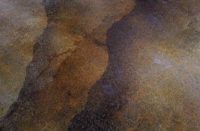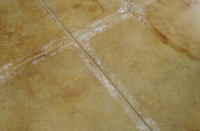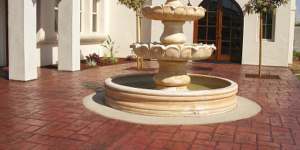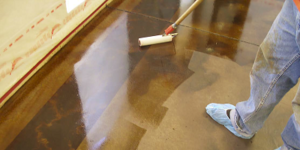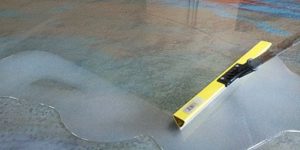Is the solution to polished concrete maintenance educating the customer on proper procedures, or is it developing better sealers to provide the customer?
I noticed a common theme this year at the World of Concrete show in conversations with leading professionals in the industry and old contractor friends alike: maintenance procedures for polished concrete. It was a popular conversation, including at the show’s polished concrete luncheon, at which it was discussed by each speaker in detail.
Each time I heard this topic being batted around, I interpreted the problem a little differently. In my opinion, what is really being discussed is how we deal with the poor results we are getting from our sealers in the polished concrete industry today. It has been my experience that the issues of stains on polished concrete (that cannot be removed through normal daily cleaning), dyes fading in some environments, and traffic patterns becoming visible on some of the semitopical sealers have as much to do with the delicate nature of the sealers available on the market today for polished concrete as they do with improper maintenance after the project has been completed.
In one such conversation with Mike DeCandia, of L.M. Scofield Co., we discussed how the current polished concrete industry is like a teenager on the way to maturity. We have not yet matured in some areas, and sealers are one of these areas.
Not too many years ago polished concrete was being marketed as a nomaintenance floor solution that needed nothing more than a hardener and maybe a fully penetrating silicone or siloxane sealer to block spills and stains. We now realize that we need a sealer with more body that will form a film on the surface to protect in grocery and food spill environments — thus the creation of the semitopical guard-type products. These improved the ability to protect from stains and lock colors into the surface but brought their own challenges to the table.
Scott Thome, also of L.M. Scofield Co. has explained it like this: Traditionally, ground and polished concrete processed with a silicate densifier and a siliconate nonfilm-forming guard will have great abrasion resistance. However, to date the only way to create resistance from organic acids is to install a physical membrane above the surface. Both systems will need to be maintained with a product that is reapplied regularly.
The contractor gets caught in the crush when the customer has been promised the best of both worlds, a situation complicated by 20-year hardener warranties that lead the customer to believe that his floor is going to be bulletproof with no maintenance for 20 years.
The obvious solution would be for our chemical providers to develop a sealer system that would:
- Protect from spills and stains
- Provide chemical resistance that is capable of resisting common cleaning chemicals such as ammonia without breaking down and stripping off the surface
- Provide abrasion resistance that is sufficient to protect the surface for an expectable length of time
- Provide a simple and compatible rejuvenation chemical to reestablish the layer of protective membrane worn away by abrasion without any need to remove residue from the initial installation before the rejuvenation process.
Mr. Thome has said he believes the future will bring protection materials that do not leave a film and also stop organic acids from etching the concrete surface. The technology exists, he says — we just need to tap into it.
The polished concrete industry at large has not found this coveted product.
To be on the safe side I recommend you be sure to offer customers a detailed maintenance plan that includes rejuvenation cycles of no longer than one year at a time for high-traffic color projects or high-profile projects such as food stores and restaurants that require the guard-type sealers for stain protection.
When dealing with an architect or an owner that has had some poor experiences with a semitopical or a dyed polished floor, be sure to explain to them that there are many different types of dye and sealer combinations and that the technology for these products and the methods of applying and maintaining those products is improving daily. Examine the maintenance methods that have been used on their problematic floors first to determine what may have caused the problem. Learn which chemicals will strip the semitopical product used and make sure they are not used going forward. Assure the customer that the floor can be restored for less cost than the original installation and that, if a proper maintenance program is implemented, it will last for years to come.
Also, pressure your chemical providers to improve the products they are providing instead of just telling you it works great for them. If that is the line they give you, remind them that you are the one the customer is calling when the weaknesses in the products are realized on the job.
Share with your chemical provider the difficulties you are experiencing in the field with your sealers or dyes. Let them know how difficult it is to explain to a customer that the simple cleaning chemicals they have been using for years on other floors have stripped the semitopical sealer off the surface and are allowing the dye to be washed out with water. Explain the need for a semitopical sealer that can either completely repel stains or be easily touched up to repair stains on the beautiful decorative floors you are installing. If the chemical company you are working with does not respond to you, go to another reputable provider and start there.
The polished concrete market must mature in this area of sealers and maintenance. We need our chemical provider partners to lead the way in that front.
The future is bright for polished concrete and growing pains are natural for a new industry. Our contractors must be proactive and make sure they are on the front edge of the learning curve, our chemical providers must lead us to the next level in sealers, and our janitorial contractors need good training programs for polished floors. These steps will insure the growth of polished concrete.
